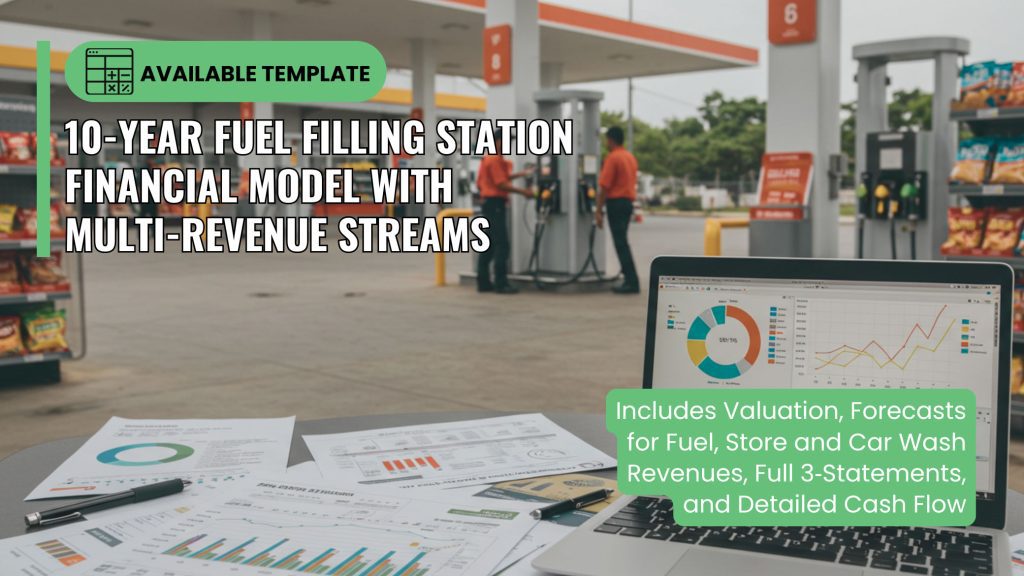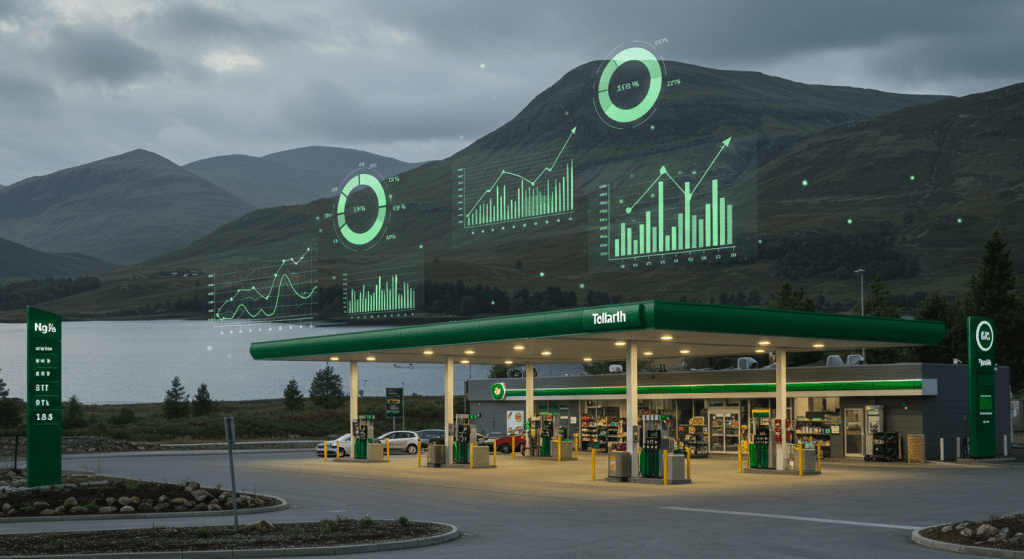
This 10-Year Fuel Station Financial Model Excel Template provides an end-to-end financial management system for entrepreneurs, investors, and established operators in the fuel retail industry. With 10-year monthly and annual forecasts, it enables users to simulate revenue, cost, and investment scenarios across three integrated business lines—fuel sales, convenience store operations, and car wash services.
The gas station financial model from Best Financial Models reflects real-world station operations, with assumptions for daily traffic, litres per car, service times, gross margins, and staff ratios, ensuring projections are both realistic and bankable. Its unique flexibility allows for simulating purchased or leased sites, adjusting depreciation, loan schedules, and CAPEX accordingly.
Each revenue stream links directly to a fully automated three-statement model (Income Statement, Balance Sheet, and Cash Flow Statement). Built-in DCF and IRR valuation modules calculate project returns and investor yields under multiple funding scenarios. Sensitivity and break-even analysis help quantify key risks and determine profitability thresholds at varying sales volumes.
The valuation dashboard consolidates financial KPIs—EBITDA, NPV, ROI, Payback Period—while providing dynamic charts for visual clarity. Users can test different combinations of fuel margins, retail sales per litre, and car wash pricing to evaluate outcomes for lenders and investors.
For strategic planning, the model assumptions tab includes editable drivers for inflation, exchange rates, loan terms, and capital expenditure, ensuring adaptability across geographies and business models. Comprehensive cost breakdowns cover utilities, maintenance, licensing, insurance, and marketing, helping identify areas for optimisation. The fuel station financial model also incorporates loan amortisation and funding mix analysis, allowing users to balance debt and equity to meet financial covenants.
Multi-year forecasts help determine liquidity needs and expansion timing. With its transparent formula structure, users can confidently adjust inputs without risking model integrity. Ideal for gas station business plans, feasibility studies, or acquisition analysis, this model combines precision, structure, and investor credibility. Whether you’re evaluating a new station or scaling an existing network, it delivers the analytical depth and strategic insight needed to make data-driven decisions.
By using this model, operators and investors can demonstrate to banks or development finance institutions (DFIs) that their assumptions are well-supported, their projections grounded, and their valuation logic consistent with industry standards.
| Component | Description |
| Dashboard | Executive summary of revenue, margins, cash flow, and IRR. |
| Cars/Day Logic | Forecasts revenue by number of cars, litres per car, and throughput capacity. |
| Multi-Revenue Streams | Up to 4 fuel types, as well as revenue assumptions from convenience store and car wash. |
| Fuel Margin Analysis | Adjustable gross margins per litre for each fuel type. |
| Break-Even Analysis | Calculates break-even on cars/day and litres. |
| Staffing Model | Staff allocation and costs per revenue channel. |
| CAPEX & Lease Options | Differentiate financials for purchased vs leased facilities. |
| Valuation | Filling station valuation model with DCF, IRR, and NPV. |
| 3 Statements | Linked P&L, Balance Sheet, and Cash Flow with monthly/annual views. |
| Scenario Planning | Sensitivity toggles for demand, pricing, costs, and CAPEX. |
The use of this financial model is solely at the user’s own risk. Best Financial Models provides the template as a tool to assist users in their business planning and decision-making processes. However, the responsibility for adhering to the model’s instructions and guidelines lies entirely with the user. Best Financial Models cannot and will not be held liable for any inaccuracies, errors, or unintended outcomes resulting from the user deviating from the prescribed usage, including but not limited to the deletion, addition, or modification of rows, columns, formulas, or any other components of the model. Users are strongly advised to exercise caution when making any changes to the model to ensure its integrity and reliability are maintained.
| Business Type | Fuel Station |
|---|---|
| File Format | Microsoft Excel |
| Forecast Period | 10 Year |
This Excel fuel station financial model provides a comprehensive 10-year forecasting framework covering all revenue streams—fuel sales, convenience store, and car wash. The template integrates fully linked Income Statement, Balance Sheet, and Cash Flow projections, combined with DCF, IRR, and payback-period valuation metrics. Each revenue line connects to cost drivers such as litres per car, fuel margins, staff wages, and utility expenses. Scenario toggles allow users to test base, optimistic, and conservative outcomes while dynamic dashboards visualise profitability, cash flow, and investment returns. Designed for both startups and established operators, it gives entrepreneurs and investors a transparent, bank-ready model that transforms operational assumptions into investor-grade financial forecasts.
This fuel station financial model converts operational details—fuel throughput, store turnover, CAPEX, and car-wash volumes—into a 10-year set of linked financial statements. Banks and investors rely on its DCF valuation and IRR outputs to verify project feasibility. Built-in loan amortisation and DSCR analysis show repayment capacity under multiple financing structures. Because every input instantly updates all results, users can present data-driven insights instead of static spreadsheets. When paired with a fuel station business plan, the model demonstrates credibility, allowing funders to see clear break-even points, realistic margins, and quantified risk. It’s an indispensable tool for entrepreneurs seeking bank loans, private-equity backing, or DFI participation in fuel-retail projects.
This gas station financial model Excel adapts seamlessly across geographies through editable inflation, exchange-rate, and tax assumptions. Its structure accommodates regional operating costs, pricing regulations, and fuel margin norms—from South Africa to broader African or global markets. Operators can calibrate litre volumes, staff wages, and lease terms to local conditions while maintaining consistent valuation logic. The DCF and IRR modules benchmark investor returns in any currency, supporting cross-border comparisons. Whether you’re modelling a suburban petrol station or an international fuel-retail chain, this Excel template delivers accurate, adaptable projections that meet global financial-modelling standards while retaining contextual flexibility for regional decision-making and lender due diligence.
The fuel station financial model Excel evaluates each business line independently—fuel, convenience store, and car wash—before consolidating results. Fuel sales depend on litres per car, cars per day, and gross margin per litre, while store and car-wash tabs use pricing, volume, and cost inputs. The model aggregates these drivers into a single dashboard displaying total EBITDA, ROI, and cash flow. Managers can test how small shifts in fuel margins or store pricing affect overall profitability. This approach provides clarity for mixed-revenue operations and enables investors to see precisely which segments generate the highest returns, improving strategic planning, capital allocation, and operational focus across the enterprise.
This petrol station financial model integrates comprehensive valuation logic. It calculates Net Present Value (NPV), Internal Rate of Return (IRR), equity multiple, ROI, and Payback Period directly from projected free cash flow outputs. These results update automatically when any assumption—fuel margin, throughput, or CAPEX—changes. Dashboards visually display valuation outcomes, helping users compare scenarios or investment cases. The DCF framework discounts cash flows at a user-defined hurdle rate, providing investors with visibility into both enterprise and equity value. This structure transforms complex valuation exercises into clear, auditable outputs, providing founders, analysts, and funders with reliable insight into profitability and capital efficiency across the project’s 10-year horizon.
This fuel station financial forecast template includes editable debt schedules for loans, bonds, or lines of credit, as well as equity modules for investor capital. Users can adjust interest rates, grace periods, and repayment tenures to simulate multiple funding options. The model calculates debt service coverage ratios (DSCR), interest expense, and post-financing cash flow, and links the results to the valuation dashboard. A dedicated funding-mix tab compares leverage scenarios to reveal optimal debt-to-equity ratios. This allows entrepreneurs and investors to assess funding feasibility and ensure compliance with lender covenants. By modelling both ownership and debt perspectives, it becomes a powerful tool for structuring sustainable, finance-ready fuel-station investments.
Yes. The fuel station financial model Excel contains detailed CAPEX and OPEX modules. CAPEX covers land, construction, pumps, tanks, canopies, and equipment—each depreciated over defined lifespans. Operating expenses include salaries, utilities, maintenance, insurance, and marketing. These feed directly into the cash-flow forecast, producing monthly and annual results. By toggling between leased and owned property scenarios, users can analyse how the financing structure influences profitability. The model’s transparency lets managers track fixed and variable costs separately, identify cost-saving opportunities, and maintain precise control over budgets. It turns complex infrastructure investments into manageable, data-driven financial plans aligned with industry benchmarks.
Absolutely. This petrol station financial model Excel features pre-configured scenario toggles for base, optimistic, and conservative projections. Adjust fuel margins, volumes, or capital costs, and the entire model recalculates in seconds. Built-in sensitivity tables show how IRR, NPV, and EBITDA respond to percentage changes in key variables. This stress-testing capability highlights risks and upside potential, making it invaluable for lenders and investors. By visualising the financial impact of pricing or cost shifts, decision-makers can choose strategies that balance growth and resilience.
The fuel station valuation model Excel includes dynamic dashboards summarising KPIs such as litres sold per day, revenue by stream, gross margin percentage, EBITDA, DSCR, IRR, NPV, and Payback Period. Colour-coded charts highlight trends in cash flow, debt service, and cumulative profit. Each graph links directly to live model data, ensuring accuracy and traceability. The dashboard enables quick interpretation for presentations or investor reports. It turns complex results into simple, actionable visuals that reveal business performance at a glance. This level of clarity helps stakeholders assess sustainability, efficiency, and investment potential with complete confidence.
This gas station financial model Excel template is ideal for entrepreneurs, investors, consultants, and analysts involved in developing or acquiring fuel-retail assets. It’s also valuable for lenders conducting feasibility reviews and for corporate teams assessing expansion or refurbishment projects. The model’s modular design enables easy adaptation to single- or multi-site operations, while valuation and KPI dashboards deliver professional outputs for investor presentations. Whether you’re preparing a fuel station business plan or conducting due diligence analysis, this model provides a robust, transparent, and data-driven financial foundation trusted by decision-makers in the fuel and retail sectors worldwide.
Unlike generic spreadsheets, this template models daily throughput (litres per car, cars per day, fuel margin per litre) alongside variable cost inputs, lease-versus-purchase options, and staffing assumptions. The user can evaluate gross margin by product line, test operational efficiency, and forecast growth scenarios with precision.
This 10-Year Fuel Station Financial Model Excel Template delivers a professional, investor-grade toolkit for entrepreneurs, operators, and analysts planning a fuel retail business (gas station). Designed with in-depth forecasts, the model integrates all major revenue channels—fuel sales, convenience store operations, and car wash income—into one fully linked and transparent financial framework.
The model includes full Income Statement, Balance Sheet, and Cash Flow projections with automated valuation outputs such as DCF, IRR, and Payback Period. Each tab is colour-coded and formula-protected for transparency and ease of editing.
A dedicated KPI dashboard visualises performance indicators, including EBITDA margin, break-even litres per day, and ROI by business line, ensuring decision-makers have clear visibility into the venture’s potential.
Built for startups, this fuel station financial model Excel supports feasibility studies, bank loan submissions, and capital-raising efforts. Its structure meets investor expectations for clarity, scalability, and accuracy — giving entrepreneurs the financial confidence to secure funding and operate sustainably.
R3,999.00
We accept various methods of payment, including Visa, Mastercard, and EFT.
Our site is secured with SSL certification and we do not store any of your payment details.
Immediate access to your chosen financial model, compatible with Excel or Google Sheets.
Our templates are designed for global use, featuring support for all major currencies.
Need a complete Business Plan, Market Research, Feasibility Study, or Investor Deck for your fuel filling station venture? Explore the services of JTB Consulting, which has been providing bespoke business planning, bank‑ready models, and investor narratives to global clients since 2006.
We don’t spam, and you can always opt out at any time.
